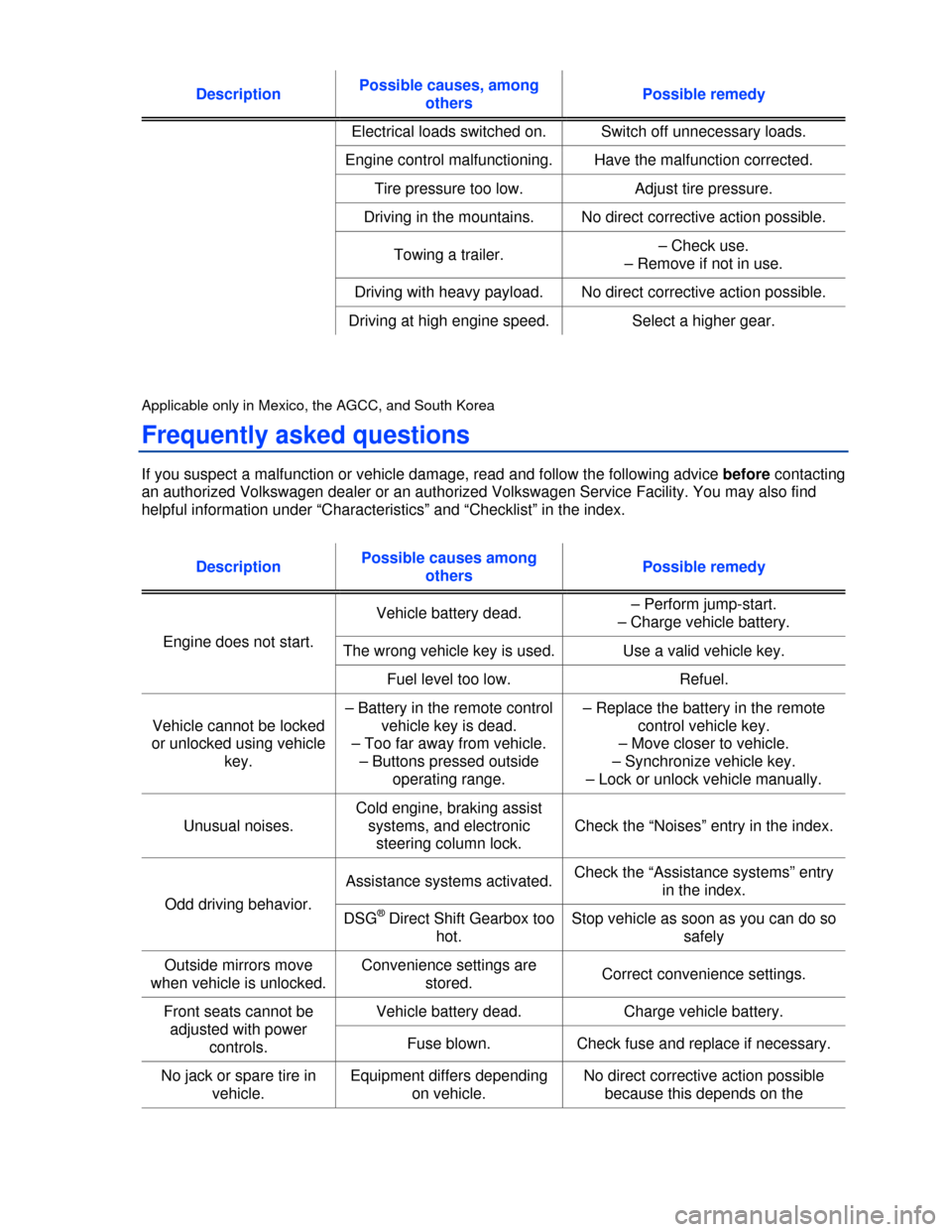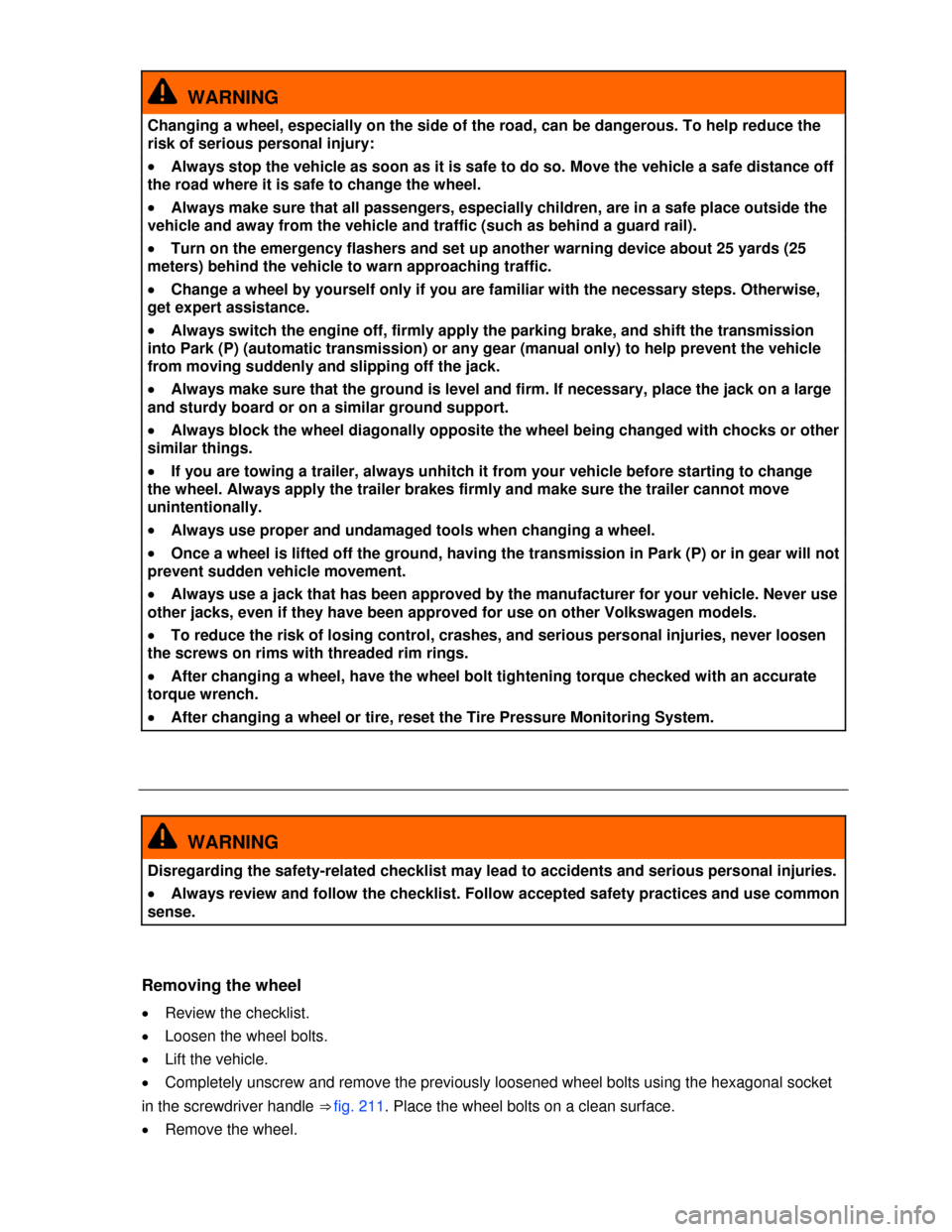2013 VOLKSWAGEN PASSAT tire pressure
[x] Cancel search: tire pressurePage 321 of 379

Section width
The linear distance between the exteriors of the sidewalls of an inflated tire, excluding elevations due
to labeling decoration, or protective bands.
Sidewall
The portion of a tire between the bead and the tread.
Sidewall separation
The parting of the rubber compound from the cord material in the sidewall.
Speed rating (letter code)
A standardized letter code indicating the maximum speed at which a tire is designed to be driven for
extended periods of time. The ratings range from 93 mph or 150 km/h (“P”) to 186 mph or (300 km/h)
“Y”.
The speed rating letter code, where applicable, is molded on the tire sidewall. You may not find this
information on all tires because it is not required by law.
Tire Pressure Monitoring System
A system that detects when at least one of a vehicle's tires is underinflated and illuminates a low tire-
pressure warning light.
Tread
The portion of a tire that normally touches the road.
Tread rib
A tread section running circumferentially around a tire.
Tread separation
Tire failure caused by the tread pulling away from the tire carcass.
Tread wear indicators (TWI)
Raised areas within the main tread grooves that show, visually, when tires are worn and near the end
of their useful life.
Uniform Tire Quality Grading (UTQG)
A tire information system developed by the U.S. National Highway Traffic Safety Administration
(NHTSA) that is designed to help buyers compare tires. UTQG is not a safety rating, nor is it a
guarantee that a tire will last for a certain number of miles or perform a certain way. It gives tire buyers
more information to compare with factors such as price, brand loyalty and dealer recommendations.
Under UTQG, tires are graded by the tire manufacturers in 3 areas: tread wear, traction and
temperature resistance. UTQG information is molded into the tire sidewalls.
U.S. DOT Tire Identification Number (TIN)
A tire's serial number. It begins with the letters “DOT” (“Department of Transportation”) and indicates
that the tire meets all federal standards. The next two numbers or letters indicate the plant where the
tire was manufactured. The last four numbers represent the week and year of manufacture.
For example, the numbers 1709 mean that the tire was produced in the 17th week of 2009. Any other
numbers are marketing codes used by the tire manufacturer. This information is used to help identify
affected consumers if a tire defect requires a recall.
Vehicle capacity weight
The total rated cargo, luggage and passenger load. Passenger load is 150 lbs (68 kilograms) times the
vehicle's total seating capacity (as listed on the label inside the driver door).
Page 323 of 379

Cord separation
The parting of cords from adjacent rubber compounds.
Cracking
Any parting within the tread, sidewall, or inner liner of the tire extending to cord material.
Cold tire inflation pressure
The tire pressure recommended by the vehicle manufacturer for a tire of a specified size that has not
been driven for more than a couple of miles (kilometers) at low speeds in the 3 hour period before the
tire pressure is measured or adjusted.
Curb weight
The weight of a motor vehicle with standard equipment including the maximum capacity of fuel, oil,
and coolant, air conditioner, and additional weight of optional equipment.
Extra load tire
A tire designed to operate at higher loads and at higher inflation pressures than the corresponding
standard tire.
Gross Axle Weight Rating (GAWR)
The load-carrying capacity of a single axle system, measured where the tire contacts the ground.
Gross Vehicle Weight Rating (GVWR)
The maximum loaded weight of the vehicle.
Groove
The space between 2 adjacent tread ribs.
Load rating (code)
The maximum load that a tire is rated to carry for a given inflation pressure. You may not find this
information on all tires because it is not required by law.
Maximum load rating
The load rating for a tire at the maximum permissible inflation pressure for that tire.
Maximum loaded vehicle weight
The total of:
�x Curb weight
�x Accessory weight.
�x Vehicle capacity weight.
�x Production options weight.
Maximum (permissible) inflation pressure
The maximum cold inflation pressure to which a tire may be inflated. Also called “maximum inflation
pressure.”
Normal occupant weight
Means 150 lbs (68 kilograms) times the number of occupants seated in the vehicle up to the total
seating capacity of your vehicle.
Occupant distribution
The placement of passengers in a vehicle.
Page 324 of 379

Outer diameter
The diameter of a new, properly inflated tire.
Overall width
Total width measured at the exterior sidewalls of an inflated tire, including the additional width of
labeling, decorations, or protective bands or ribs.
Passenger car tire
A tire intended for use on passenger cars, multipurpose passenger vehicles, and trucks, that have a
gross vehicle weight rating (GVWR) of 10,000 pounds or less.
Ply
A layer of rubber-coated parallel cords.
Ply separation
A parting of rubber compound between adjacent plies.
Pneumatic tire
A mechanical device made of rubber, chemicals, fabric, and steel or other materials, that, when
mounted on an automotive wheel, provides the traction and contains the gas or fluid that sustains the
load.
Production options weight
The combined weight of installed regular production options weighing over 5 lbs (2.3 kg) more then the
standard items they replace, and not previously considered as curb weight or accessory weight. These
include, for example, heavy-duty brakes, ride levelers, heavy-duty battery, and special trim.
Radial ply tires
A pneumatic tire in which the ply cords that extend to the beads are laid at substantially 90 degrees to
the centerline of the tread.
Recommended inflation pressure
The tire pressure recommended by the vehicle manufacturer for a tire of a specified size that has not
been driven for more than a couple of miles (kilometers) at low speeds in the 3 hour period before the
tire pressure is measured or adjusted.
Reinforced tire
A tire designed to operate at higher loads and at higher inflation pressures than the corresponding
standard tire.
Rim
The outer edge of a wheel upon which the tire beads are seated.
Rim diameter
The nominal diameter of the wheel's tire bead seating surface. If you change your wheel size, to
wheels of a different diameter, you will have to purchase new tires to match the new wheels.
Rim size
Designation means rim diameter and width.
Rim type designation
The industry or manufacturer's designation for a rim by style or code.
Rim width
The nominal distance between wheel rim flanges.
Page 325 of 379

Section width
The linear distance between the exteriors of the sidewalls of an inflated tire, excluding elevations due
to labeling decoration, or protective bands.
Sidewall
The portion of a tire between the bead and the tread.
Sidewall separation
The parting of the rubber compound from the cord material in the sidewall.
Speed rating (letter code)
A standardized letter code indicating the maximum speed at which a tire is designed to be driven for
extended periods of time. The ratings range from 93 mph or 150 km/h (“P”) to 186 mph or (300 km/h)
“Y”.
The speed rating letter code, where applicable, is molded on the tire sidewall. You may not find this
information on all tires because it is not required by law.
Tire Pressure Monitoring System
A system that detects when at least one of a vehicle's tires is underinflated and illuminates a low tire-
pressure warning light.
Tread
The portion of a tire that normally touches the road.
Tread rib
A tread section running circumferentially around a tire.
Tread separation
Tire failure caused by the tread pulling away from the tire carcass.
Tread wear indicators (TWI)
Raised areas within the main tread grooves that show, visually, when tires are worn and near the end
of their useful life.
Uniform Tire Quality Grading (UTQG)
A tire information system developed by the U.S. National Highway Traffic Safety Administration
(NHTSA) that is designed to help buyers compare tires. UTQG is not a safety rating, nor is it a
guarantee that a tire will last for a certain number of miles or perform a certain way. It gives tire buyers
more information to compare with factors such as price, brand loyalty and dealer recommendations.
Under UTQG, tires are graded by the tire manufacturers in 3 areas: tread wear, traction and
temperature resistance. UTQG information is molded into the tire sidewalls.
U.S. DOT Tire Identification Number (TIN)
A tire's serial number. It begins with the letters “DOT” (“Department of Transportation”) and indicates
that the tire meets all federal standards. The next two numbers or letters indicate the plant where the
tire was manufactured. The last four numbers represent the week and year of manufacture.
For example, the numbers 1709 mean that the tire was produced in the 17th week of 2009. Any other
numbers are marketing codes used by the tire manufacturer. This information is used to help identify
affected consumers if a tire defect requires a recall.
Vehicle capacity weight
The total rated cargo, luggage and passenger load. Passenger load is 150 lbs (68 kilograms) times the
vehicle's total seating capacity (as listed on the label inside the driver door).
Page 344 of 379

Description Possible causes, among
others Possible remedy
Electrical loads switched on. Switch off unnecessary loads.
Engine control malfunctioning. Have the malfunction corrected.
Tire pressure too low. Adjust tire pressure.
Driving in the mountains. No direct corrective action possible.
Towing a trailer. – Check use.
– Remove if not in use.
Driving with heavy payload. No direct corrective action possible.
Driving at high engine speed. Select a higher gear.
Applicable only in Mexico, the AGCC, and South Korea
Frequently asked questions
If you suspect a malfunction or vehicle damage, read and follow the following advice before contacting
an authorized Volkswagen dealer or an authorized Volkswagen Service Facility. You may also find
helpful information under “Characteristics” and “Checklist” in the index.
Description Possible causes among
others Possible remedy
Engine does not start.
Vehicle battery dead. – Perform jump-start.
– Charge vehicle battery.
The wrong vehicle key is used. Use a valid vehicle key.
Fuel level too low. Refuel.
Vehicle cannot be locked
or unlocked using vehicle
key.
– Battery in the remote control
vehicle key is dead.
– Too far away from vehicle.
– Buttons pressed outside
operating range.
– Replace the battery in the remote
control vehicle key.
– Move closer to vehicle.
– Synchronize vehicle key.
– Lock or unlock vehicle manually.
Unusual noises.
Cold engine, braking assist
systems, and electronic
steering column lock.
Check the “Noises” entry in the index.
Odd driving behavior.
Assistance systems activated. Check the “Assistance systems” entry
in the index.
DSG® Direct Shift Gearbox too
hot.
Stop vehicle as soon as you can do so
safely
Outside mirrors move
when vehicle is unlocked.
Convenience settings are
stored. Correct convenience settings.
Front seats cannot be
adjusted with power
controls.
Vehicle battery dead. Charge vehicle battery.
Fuse blown. Check fuse and replace if necessary.
No jack or spare tire in
vehicle.
Equipment differs depending
on vehicle.
No direct corrective action possible
because this depends on the
Page 345 of 379

Description Possible causes among
others Possible remedy
Vehicle has run-flat or mobility
tires.
equipment. Contact an authorized
Volkswagen dealer or an authorized
Volkswagen Service Facility for
assistance.
Features do not work as
described in this manual.
Settings were adjusted in the
Volkswagen Information
System.
Check and reset to factory settings if
necessary.
Headlights do not light up
the road as they should.
– Headlights adjusted too high.
– Light bulbs burned out.
– Low beams not switched on.
– Have the headlight range adjusted by
an authorized Volkswagen dealer or an
authorized Volkswagen Service
Facility.
– Change light bulbs.
– Switch on low beams.
Electrical consumers do
not work.
Vehicle battery charge too low. Charge vehicle battery.
Remaining fuel level too low. Refuel.
Fuse blown. Check fuse and replace if necessary.
Fuel consumption higher
than indicated.
– Short hauls.
– “Jumpy” accelerator pedal.
– Avoid short distance driving.
– Drive defensively.
– Accelerate smoothly.
Electrical loads switched on. Switch off unnecessary loads.
Engine control malfunctioning. Have the malfunction corrected.
Tire pressure too low. Adjust tire pressure.
Driving in the mountains. No direct corrective action possible.
Towing a trailer. – Check use.
– Remove if not in use.
Driving with heavy payload. No direct corrective action possible.
Driving at high engine speed. Select a higher gear.
Page 364 of 379

WARNING
Changing a wheel, especially on the side of the road, can be dangerous. To help reduce the
risk of serious personal injury:
�x Always stop the vehicle as soon as it is safe to do so. Move the vehicle a safe distance off
the road where it is safe to change the wheel.
�x Always make sure that all passengers, especially children, are in a safe place outside the
vehicle and away from the vehicle and traffic (such as behind a guard rail).
�x Turn on the emergency flashers and set up another warning device about 25 yards (25
meters) behind the vehicle to warn approaching traffic.
�x Change a wheel by yourself only if you are familiar with the necessary steps. Otherwise,
get expert assistance.
�x Always switch the engine off, firmly apply the parking brake, and shift the transmission
into Park (P) (automatic transmission) or any gear (manual only) to help prevent the vehicle
from moving suddenly and slipping off the jack.
�x Always make sure that the ground is level and firm. If necessary, place the jack on a large
and sturdy board or on a similar ground support.
�x Always block the wheel diagonally opposite the wheel being changed with chocks or other
similar things.
�x If you are towing a trailer, always unhitch it from your vehicle before starting to change
the wheel. Always apply the trailer brakes firmly and make sure the trailer cannot move
unintentionally.
�x Always use proper and undamaged tools when changing a wheel.
�x Once a wheel is lifted off the ground, having the transmission in Park (P) or in gear will not
prevent sudden vehicle movement.
�x Always use a jack that has been approved by the manufacturer for your vehicle. Never use
other jacks, even if they have been approved for use on other Volkswagen models.
�x To reduce the risk of losing control, crashes, and serious personal injuries, never loosen
the screws on rims with threaded rim rings.
�x After changing a wheel, have the wheel bolt tightening torque checked with an accurate
torque wrench.
�x After changing a wheel or tire, reset the Tire Pressure Monitoring System.
WARNING
Disregarding the safety-related checklist may lead to accidents and serious personal injuries.
�x Always review and follow the checklist. Follow accepted safety practices and use common
sense.
Removing the wheel
�x Review the checklist.
�x Loosen the wheel bolts.
�x Lift the vehicle.
�x Completely unscrew and remove the previously loosened wheel bolts using the hexagonal socket
in the screwdriver handle ⇒ fig. 211. Place the wheel bolts on a clean surface.
�x Remove the wheel.
Page 378 of 379

Abbreviations
Abbreviation Meaning
5S manual 5-speed manual transmission
6S automatic 6-speed automatic transmission
6S manual 6-speed manual transmission
ABS Anti-lock Brake System
AFS Adaptive Front Lighting System
AKI Anti-Knock Index
ANSI American National Standards Institute
ASR Anti-Slip Regulation
ATA Anti-Theft Alarm system
BAS Brake Assist System
ccm Cubic centimeters - unit of measure for engine displacement
CCS Cruise Control System
CID Cubic inches - unit of measure for engine displacement
cm Centimeter - metric unit of measure for length
CO2 Carbon dioxide
DIN Deutsches Institut für Normung (German Institute for Standardization)
DPF Diesel Particulate Filter
DRL Daytime running lights
DSG® DSG® Direct Shift Gearbox automatic transmission
EDL Electronic Differential Lock
EN European Norm
EPC Engine control (Electronic Power Control)
ESC Electronic Stability Control
FSI Fuel Stratified Injection
g/km Generated carbon monoxide amount in grams per kilometer driven
GAWR Gross Axle Weight Rating
GVWR Gross Vehicle Weight Rating
HID High Intensity Discharge headlights (Xenon)
hp Horsepower - unit to measure engine power
kg Kilogram - metric unit for weight
kN Kilonewton - a measure of force
kp Kilopond - a measure of force
kPa Kilopascal - unit of measure for tire pressure
kW Kilowatt - engine rating